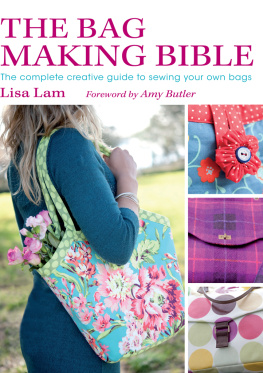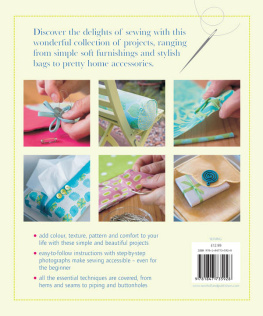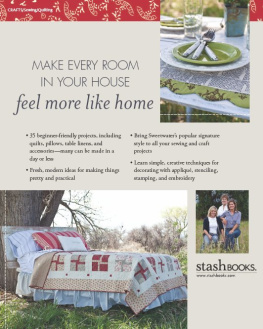

If you sew as a hobby, the chances are you already have most of the essential equipment for bag making. As with most things you get what you pay for, so buy the best you can afford and youll need to replace items less often.
CUTTING
Rotary cutter a rotary cutter greatly increases the speed and accuracy of fabric cutting. Also look out for rotary blade sharpeners, which will save you money on replacing dull blades.
Cutting mat for use with a rotary cutter. Choose one that has both imperial and metric gridlines (inches and centimetres). The gridlines are also really helpful when drafting your own bag patterns.
Dressmaking scissors choose scissors that cut all the way through to the tip, are as heavy as is comfortable (as the weight aids cutting stability), and are angled with the handles raised upwards.
Embroidery scissors small, fine-pointed scissors are essential for precision snipping.
Seam ripper for unpicking seams and perfect for making tiny incisions for magnetic snaps and buttonholes. Always replace dull seam rippers to prevent you from having to push too hard, which could result in slipping and tearing the fabric.
Sharpen up
Keep blades on all cutting equipment sharp for safer and more precise cutting.
MARKING, MEASURING AND PINNING
Disappearing marker this is my favourite type of marker because it is more precise than chalk. Make your marks as desired and they will disappear within 48 hours. Always do a test on a small swatch of fabric to check suitability first.
Hera marker (or bone folder) this useful tool makes an indent in your fabric from pressure only, so its perfect if your fabric is unsuitable for a disappearing marker. It is also great for pre-creasing fabric when making folds or pleats.
Tape measure to make measurement conversions easier, choose a tape measure with both metric and imperial measurements printed on the same side.
Sewing pins I love flower flathead pins because they are pretty and they prevent sore fingertips, sometimes caused by pushing pins through lots of layers.
Hand-sewing needle although you will be mostly sewing by machine, there are times when hand sewing is unavoidable such as when the sewing machine cant reach the areas you need to stitch, or when sewing on buttons for example.
BAG-MAKING TOOLS
None of these tools are exotic or hard to obtain. They are all simple items, which I have collected over the years. To make life easier and to get the best results from your bag making, try adding these items to your tool kit.
Bodkin a bodkin is used for speedy threading of cord or elastic through fabric tubes or casings. Attach the cord/elastic to the bodkin and thread the bodkin through your fabric tube.
Tailors awl an awl is useful for making holes in fabric for rivets, poking out corners in fine straps (when turning out), or even coaxing small parts of your bag underneath the sewing machine foot (to help the feed dogs grab the fabric). Two types are available one with a sharp point, the other with a ballpoint tip.
Hole punch use a hole punch to cut neat holes in fabric for eyelets or popper snaps. This hole punch has various sized hole-cutter attachments and a smaller grip, which is great for small hands.
Fabric glue use good-quality clear-drying fabric glue for when sewing isnt an option. Good fabric glue can be just as effective as stitching.
Thread for ease of use and to make long-lasting bags, use good quality all-purpose polyester thread. It might be tempting to buy cheaper thread but this breaks more easily, which makes it unsuitable for bag making.
Loop turner this simple tool is used for turning fabric tubes the right way out for speedy fabric strap making.
Sewing clips/mini bulldog clips use these strong clips to hold pieces of fabric together temporarily when sewing pins are unsuitable, such as when your layers are very thick.
Hammer and pliers use a small hammer when you are working with rivets and eyelets (grommets). Use two pairs of pliers for opening and closing metal rings and links in purse chains. Jewellery pliers are especially suited to those with small hands.
A sewing machine is the most important tool in making bags but it doesnt need to be a grand or costly affair. There are only two features that I insist on: a powerful motor and a free arm. The others listed here, while not essential, are useful to have.
Powerful motor a must for coping with all of those fabric (and interfacing) layers.
Good stability when sewing at breakneck speeds or working with thick layers, the last thing you want is your machine to shake and judder. Choose a machine that has a good weight and a wide, stable base. Ask to see or test the machine in action at maximum speed.
Build quality how solid does the machine feel? I prefer heavy machines (the more metal the better) because they will last longer (with fewer machine services) and they will vibrate less.
Instruction manual I am a stickler for a good manual because no matter how experienced you are there will be plenty of occasions when youll need to turn to it for help. Dont be shy in the shop ask to have a flick through the machine manual. Also look on the internet for support and user manuals for your machine.
Bobbin winding system different sewing machines have different systems for bobbin winding. While in the shop, ask to see how the bobbin is wound and check you are happy with the method.
Dual feed system this is a feature on some sewing machines that makes working with several and/or thick layers much easier because this system feeds the layers through the machine evenly and at the same speed. In normal sewing, the bottom layer gets fed through the machine just before the top layer and this results in the top layer creeping forwards, which can be a real pain.
MACHINE FEET
There are various feet required for different kinds of stitches and applications, so you need to think about the stitches you want to use and research to see which types of feet are appropriate for your needs. If you are about to purchase a sewing machine, see which feet are supplied with the machine, then ask the dealer if they will throw in some extra feet for free (and ask about any other freebies too!).
Standard presser foot this is the foot that you will make the most use of. With this versatile foot you can sew straight and zigzag stitch, and the majority of the more decorative stitches too.
Clear presser foot this is a standard presser foot, but instead of being metal, its made from transparent plastic, which makes seeing things like notches and markings on your fabric so much easier.
Next page



















